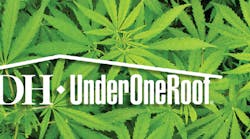KELLI JAECKS, MA, RDH – will lead a seminar titled, “Cannabis Culture and Dentistry:THC, CBD, BFF or OMG? Clinical Considerations for the Dental Professional in this Growing Weed World,” at the RDH Under One Roof conference in August.
Jaecks is a past president of the American Dental Hygienists’ Association. In March, Jaecks published her book, “Martinis and Menopause,” a self-help book written for women in the perimenopause, menopause, and post-menopause stages of life.
We asked Jaecks the questions below regarding her seminar on marijuana at RDH Under One Roof.
RDH: Due to the number of states allowing some form of legalized marijuana consumption, hygienists are increasingly likely to encounter a user who consumes it legally. Given the traditional mindset of dental professionals who have been exposed to decades of studies regarding the oral health of marijuana users, what is the new paradigm that dental hygienists must be prepared for with this group of patients?
Jaecks: One, our judgmental and cultural bias needs to be addressed and acknowledged. The new Weed World is very different from when most of us were younger and considered smoking pot. There are many ways to ingest marijuana that do not include smoking or vaping, and we have a greater understanding of what cannabis does in the body. As health professionals, creating a safe space for our patients to answer a health history is primary.
RDH: In your course, you plan to devote some time to discussing the various types of cannabis plants. Why do you think it is important to share this information?
Jaecks: Absolutely. The importance lies in understanding how the different types, or strains of cannabis affect the body. For example, some types of medical use marijuana have little to zero THC, meaning a person doesn’t get “high” when using. The strains become important for both medical and recreational users, depending on why they are using. Is it to relieve pain, relax, feel uplifted, or go to sleep? The intended outcome of the cannabis is what drives the decision of type and strain.
RDH: Should the different methods of marijuana consumption be a part of oral hygiene instructions?
Jaecks:The hygienist should have a working knowledge of the relative risk factors of the different methods of consuming marijuana to better instruct the patient towards health. For example, the oral health risks of inhaling cannabis differ from the risks of eating edibles or using a sublingual oil.
RDH: What is the primary question that a dental hygienist should be asking a marijuana user who is consuming the drug legally?
Jaecks: There are few questions a health professional would want the answers to, including: What type of marijuana are you using? Do you know the THC/CBD concentration? How do you use it (type of delivery)? Are you using it to treat a medical condition? What is that? How often and how long have you been using? Are you under the influence now? We may have more questions than answers today, and we are definitely in a historical shift regarding cannabis use. Come be a part of my course at UOR. There is more information to come!
––– JAECK'S SEMINAR –––
8 am | Friday, August 3
Gaylord National Resort & Convention Center in National Harbor, Md.
For more information about RDH Under One Roof, visit RDHUnderOneRoof.com.








